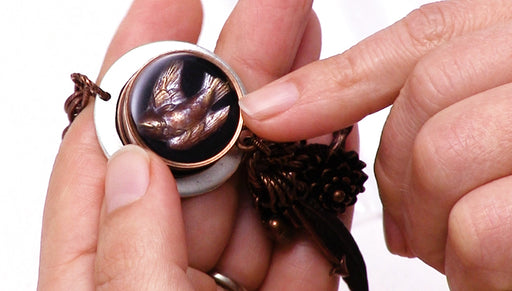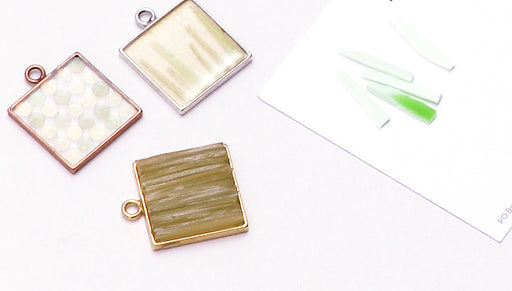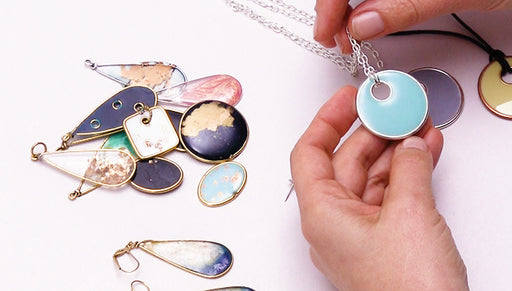
|
Nunn Design Open Bezel Pendant, Circle with Channel 24.5x29.5mm, Ant. Silver (1 Pc) SKU: PND-00620 $6.89 |

|
Nunn Design 2-Part Epoxy Resin Kit, Jewelers Grade Clear, 8 Oz Kit SKU: TRC-14 $44.09 |

|
Easy Mold Silicone Molding Putty for Casting and Jewelry Making 1/2 Pound SKU: TRC-60 $24.99 |

|
CASTIN CRAFT Casting Epoxy Resin Opaque White Pigment Dye 1 Oz SKU: TRC-87 $10.99 |

|
Crystal Clay Sparkle Dust - Mica Powder 'Silver' 1.5g SKU: XTL-1155 $5.79 |

|
Casting Epoxy Resin Mixing Cup Set With Brushes and Sticks SKU: TRC-01 $13.99 |
hi this is becky nunn with nunn design and I'm a guest designer with beadaholique I'd like to show you how you can create sculpted resin pieces like in these samples here to do this technique you'll want to have the following tools and ingredients I have a two-part silicon putty I've already pinched off equal sized balls I have the Nunn design two-part resin it's already pre-mixed I have a couple of different mica powders or you can use casting crap color pigments this is what we're going to use to colorize the resin and then a couple stir sticks and q-tips we also have some Nunn design open back bezel and for this particular project I'm going to show you how you can use organics to create your sculpted resin let me show you why this technique is so awesome when I was playing around with creating molds I was creating molds and then casting the pieces and then it was challenging to figure out where I wanted to use those pieces unless I wanted to drill them or attach them somehow into an undesigned bezel and in this case I used two part resin underneath and then stuck this piece on the top then I thought well wouldn't it be neat if you could actually create a mold and then put the bezel right into that mold and then pour the resin and therefore coming out with a piece that you didn't need to attach it was already built in and that's how the idea of creating this technique came about so let me show you how to do that you're going to pinch off equal size balls of the silicon putty but before you mix that because you have such a small window to do so you want to make sure that you're all set up with what it is that you want to have your design be and so I'm using one of these open back bezel zuv Nunn design and we have a variety of open back bezel this particular one is a cast piece and these are actually brass pieces the pieces that are brass these can be used over and over and over again once you press that in there because they are precision made so every single piece will be exactly the same dimensions and therefore when you press it into that molding putty there won't be any leakage out of the sides versus a piece like this this is cast and then it's plated and it goes through a process where it can be easily dinged and marred so once you press this into your putty and then you want to make another one use it into the next mold you might have some seepage out the sides because this isn't precision hope you followed me there but that's the best way I can explain it you'll know because I agree what I'm talking about if you ever have any resin leaked out the sides it will be because it's a cast piece so let's go ahead and get started on this so I have a couple of pieces of organics that I've already trimmed out and thought about like how do I want those to be laid out with inside of my piece and it's important to have a really clear idea of what you want to do inside that piece before you mix up the silicon putty you have literally one minute minute and a half to work with this before it starts to harden and it no longer will take an impression so you want to be prepared so I have my design I'm also going to have out a piece of a card stock to work on and then I'll also use a little bag to place my putty on just so it doesn't stick to the surface of my work area alright so now I'm ready so I have equal size balls these were balls and they've kind of just morphed down into puddles you're going to mix these two parts until they are no long grrrrrr marbled so I like to use the palms of my hand and just move the putty back and forth until it's no longer marbled once it looks like it's pretty mixed a little bit more to go you're going to roll it into a nice smooth round ball and see how I'm using the palms of my hands kind of arching my fingers back gives me a nice flat surface to work with so now I have a nice ball and this is the container of the silicon putty I'm just using that to flatten down and make a nice little patty you want to have enough of the putty or a big enough shape to fit that bezel so I'll squeeze it down a little bit more now I have a nice flat putty and I'm going to place my bezel in and press down gently and then I'm going to take my little organics actually I like it just like that and you're going to press that down into the putty and if you need to you can go in with a toothpick and just gently press it down into the molding putty then you're going to let that set and it will take it'll set pretty much in about let's see five minutes that will be probably ready these pieces here I actually used a real nautilus for that and this was a brass stamping but you can see that the same process was done with creating this mold here press my brass stamping in I actually took the brass stamping out and then pressed in this afterwards now let that set up for just a little bit and then we'll go ahead and work with the mold while you're letting your silicon putty set up you can start thinking about how you want to do your design in this example I think what I'd like to do is I'll use a gold pearl X mica powder to go into the base where the flowers now are and then I think I'll go ahead and then pour into the bezel some mixed resin with this color of mica powder I have no idea what this is going to look like so we're just going to have to go with it so I've already mixed some Nunn design resin this is the Nunn design two-part resin and I'm going ahead and placing in a little bit of mica powders into that clear resin and stirring this up this is already getting pretty thick but I think this will hopefully still work just giving it a fun sort of you're a decent teal color now we're going to set that aside let's take a look at how we're doing with our our putty and now this is very firm to the touch so I can go ahead and come in I'm going to leave that bezel in its position because like I mentioned that is it's this molding putty example is designed specifically to go with this particular bezel and I'm just going to remove my little bit of organics that were in there now you can see my impression in there I'm just super curious to see what that's going to look like when the resin hits it so I mixed up a little bit of two-part epoxy clay and you could do this with playdough or something else but I just kind of want to see what that design is going to look like that's pretty interesting if I didn't like that or if this mold didn't look interesting I could go ahead and and start another impression but that looks kind of that looks like it could be really neat so the next step of what I'm going to do is I'm going to use the mica powders and a q-tip and I'm going to go into the base of this and just smear some around so that I can get some really good highlights down in those recessed areas and actually it might like kind of cool if I just have the whole thing kind of covered like such and then just tap it to get any of the excess mica powders out now with our colorized mica powder wow this is getting thick we're going to go ahead and drizzle some down into the base of our bezel all right before I get too much in there I'm going to stop and use my toothpick to move that resin around inside of there I'm also going along the side edges to make sure that I don't have any air pockets and then you're going to let that set until heart it takes about 12 hours for that to get really hard if you want you can go along side edge if you have any excess resin on the side and clean that up then once that is all ready this is when I did earlier on this I mixed up some black crafting casting craft opaque pigments in with my clear resin and I had gold mica powder on the base and then when you were done you come in and you peel back you side edges and your piece will pop out this is pretty interesting but you can see that I had some right here on my organics that's kind of a little bit funky if I wanted to I could put another coat of clear resin over the top of that to give it an interesting look and it would fill in that little hole right there but that's pretty pretty neat as it is when I was talking about earlier how sometimes the resin can seep out this is in another example of a cast piece versus a precision brass piece and I poured in a little bit of the clear resin and I could see that it was sliding out the top out of the bottom so I just stopped and let that piece cure it fully cured and you can see it had a really cool effect where it's has like a partial coverage and then this also had it and I just filled in additional I put tape at the back of this and just put additional resin over the top to create that really interesting funky look I mean I love it bubbles and all it just it just looks so unusual and that was kind of a fun expert ory play but really figuring out why was it seeping out of the side on some and not others really came down to the fact that these were cast pieces and you can see that it does involve some cleanup and this just takes a pair of needle nose pliers to kind of pick out this and then it peels off but this technique works it just requires more cleanup than if you were using a brass precision piece though this is becky nunn showing you how you can create a sculpted resin piece using organics or you can use brass stampings you can use colorized resin or you can use mica powders to create really interesting pieces thanks for joining me you
Related Videos


How to Create a Shadow Box Pendant with Nunn Design Resin by Becky Nunn
In this video you will see how to colorize a stamping using mica powder and Nunn Design sealant, how to use a 2 part epoxy clay and how to pour cle...
View full details

How to Use Excess Colorized Resin Pieces to Create Mosaic Pendants by Becky Nunn
In this video you will learn how to use the last bit of resin from your projects to make a mosaic pattern in a new pendant. This is a great techni...
View full details

How to Use Colorized Resin in an Open Frame Hoop by Becky Nunn
In this video you will learn how to use colorized resin in an open frame hoop to create pendants and components for your jewelry. For this techniq...
View full details